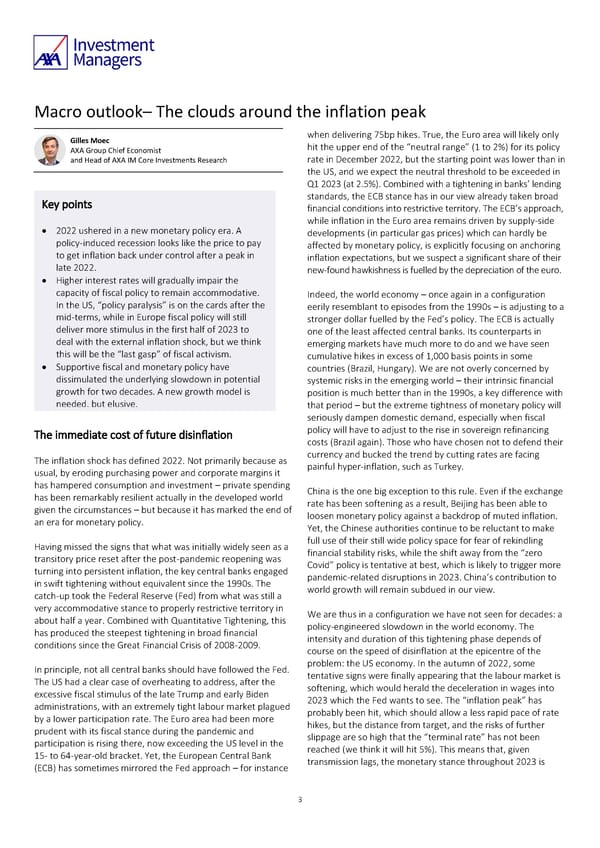Macro outlook– The clouds around the inflation peak Gilles Moec when delivering 75bp hikes. True, the Euro area will likely only AXA Group Chief Economist hit the upper end of the “neutral range” (1 to 2%) for its policy and Head of AXA IM Core Investments Research rate in December 2022, but the starting point was lower than in the US, and we expect the neutral threshold to be exceeded in Q1 2023 (at 2.5%). Combined with a tightening in banks’ lending Key points standards, the ECB stance has in our view already taken broad financial conditions into restrictive territory. The ECB’s approach, while inflation in the Euro area remains driven by supply-side • 2022 ushered in a new monetary policy era. A developments (in particular gas prices) which can hardly be policy-induced recession looks like the price to pay affected by monetary policy, is explicitly focusing on anchoring to get inflation back under control after a peak in inflation expectations, but we suspect a significant share of their late 2022. new-found hawkishness is fuelled by the depreciation of the euro. • Higher interest rates will gradually impair the capacity of fiscal policy to remain accommodative. Indeed, the world economy – once again in a configuration In the US, “policy paralysis” is on the cards after the eerily resemblant to episodes from the 1990s – is adjusting to a mid-terms, while in Europe fiscal policy will still stronger dollar fuelled by the Fed’s policy. The ECB is actually deliver more stimulus in the first half of 2023 to one of the least affected central banks. Its counterparts in deal with the external inflation shock, but we think emerging markets have much more to do and we have seen this will be the “last gasp” of fiscal activism. cumulative hikes in excess of 1,000 basis points in some • Supportive fiscal and monetary policy have countries (Brazil, Hungary). We are not overly concerned by dissimulated the underlying slowdown in potential systemic risks in the emerging world – their intrinsic financial growth for two decades. A new growth model is position is much better than in the 1990s, a key difference with needed, but elusive. that period – but the extreme tightness of monetary policy will seriously dampen domestic demand, especially when fiscal The immediate cost of future disinflation policy will have to adjust to the rise in sovereign refinancing costs (Brazil again). Those who have chosen not to defend their The inflation shock has defined 2022. Not primarily because as currency and bucked the trend by cutting rates are facing usual, by eroding purchasing power and corporate margins it painful hyper-inflation, such as Turkey. has hampered consumption and investment – private spending has been remarkably resilient actually in the developed world China is the one big exception to this rule. Even if the exchange given the circumstances – but because it has marked the end of rate has been softening as a result, Beijing has been able to an era for monetary policy. loosen monetary policy against a backdrop of muted inflation. Yet, the Chinese authorities continue to be reluctant to make Having missed the signs that what was initially widely seen as a full use of their still wide policy space for fear of rekindling transitory price reset after the post-pandemic reopening was financial stability risks, while the shift away from the “zero turning into persistent inflation, the key central banks engaged Covid” policy is tentative at best, which is likely to trigger more in swift tightening without equivalent since the 1990s. The pandemic-related disruptions in 2023. China’s contribution to catch-up took the Federal Reserve (Fed) from what was still a world growth will remain subdued in our view. very accommodative stance to properly restrictive territory in about half a year. Combined with Quantitative Tightening, this We are thus in a configuration we have not seen for decades: a has produced the steepest tightening in broad financial policy-engineered slowdown in the world economy. The conditions since the Great Financial Crisis of 2008-2009. intensity and duration of this tightening phase depends of course on the speed of disinflation at the epicentre of the In principle, not all central banks should have followed the Fed. problem: the US economy. In the autumn of 2022, some The US had a clear case of overheating to address, after the tentative signs were finally appearing that the labour market is excessive fiscal stimulus of the late Trump and early Biden softening, which would herald the deceleration in wages into administrations, with an extremely tight labour market plagued 2023 which the Fed wants to see. The “inflation peak” has by a lower participation rate. The Euro area had been more probably been hit, which should allow a less rapid pace of rate prudent with its fiscal stance during the pandemic and hikes, but the distance from target, and the risks of further participation is rising there, now exceeding the US level in the slippage are so high that the “terminal rate” has not been 15- to 64-year-old bracket. Yet, the European Central Bank reached (we think it will hit 5%). This means that, given (ECB) has sometimes mirrored the Fed approach – for instance transmission lags, the monetary stance throughout 2023 is 3
 AXA IM Outlook 2023 full report Page 2 Page 4
AXA IM Outlook 2023 full report Page 2 Page 4